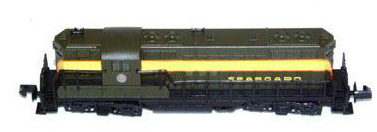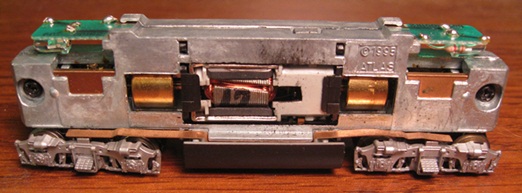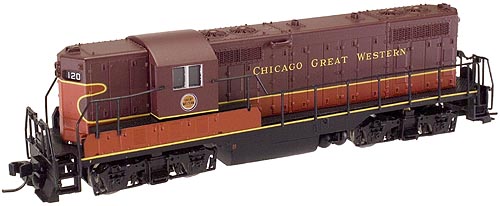



Introduced: 1987 (Kato-made GP7/GP9), 1995 (Atlas Classic GP7), 1996 (Atlas Classic GP9), 1997 (Torpedo-Tube GP9), 2002 (Torpedo-Tube GP7), 2004 (Slow-Speed Motor GP7/GP9), 2006 (DCC GP7/GP9), 2007 (DCC Torpedo-Tube GP7/GP9), and 2024 (DCC Sound GP7/GP9)
GP7 and GP9 models have been an Atlas staple for decades. And not surprisingly, they come in a wide array of different versions. The very first Atlas Geep (a GP9) was manufactured in Austria by Roco in the 1970s. However, I won't be discussing those here (as they are ably covered elsewhere in this encyclopedia). But do take note - those old Roco-made Geeps are vastly inferior to all of the subsequent versions (IE, eBay bidders beware).
The first post-Roco Atlas GP7 and GP9 models (pictured above) were manufactured in Japan by Kato. And unfortunately, they represent a rare miscue for Atlas. For some strange reason, Atlas decided to release a pair of models that simply don't look right - and not just a little bit not right, but a whole lot not right. I mean, even to an untrained observer such as myself, the huge gaps between the ends of the trucks and the ends of the shell look pretty awful. The problem here is that Atlas tried to shoehorn an existing mechanism (the one from their hugely successful 1983 Alco RS-3 model) into a new model (presumably to save money on tooling). And although a fine running mechanism, it just don't work as a Geep -

Features include a split-frame metal chassis, split-frame metal truck assemblies, blackened wheels, all-wheel drive (no traction tires), and all-wheel pick-up. The motor is an open-sided 5-poler. All gearing is plastic. Directional lighting is provided by PC boards mounted on either end of the chassis. The couplers are truck-mounted Rapidos (open pilots). Wheels are low-profile and have no problems on Code-55 track. No flywheels, though (those wouldn't show up on an Atlas/Kato model until their 1988 RS-1).
Performance on these models is most excellent. They run smoothly and quietly at all throttle levels. Pickup is flawless, slow-speed creep is superb, and pulling power is impressive. The top-end speed is a bit high, but that's a minor nitpick. So, yeah, they run great (as did all the models based on that same RS-3 mechanism). But obviously, it's the looks here that are the deal-breaker.
Trivia - In the late 1980s, custom replacement frames for these models were introduced by two different companies (JnJ Trains and N scale of Nevada). These supposedly fixed all the truck problems (allegedly putting them where they belong). Now, you can draw your own conclusions as to the viability of said do-it-yourself frames. I mean, I'm not sayin', I'm just sayin'...
Atlas eventually severed their ties with Kato in the mid-90s. And shortly thereafter, these models were re-released under the new "Atlas Classic" line (redesigned/retooled Chinese-manufactured remakes of the old Kato-made models).
For whatever reason, it was at this point that Atlas decided to introduce the whole concept of "Phases" into their Geeps (EG, "Phase 1" and "Phase 2"). And from what I've beem told, said variations basically boil down to trivial shell details (pilot angle, battery box size, louver counts, sidesill notches, and suchlike). Unfortunately, even seasoned loco spotters seem to have problems reconciling Atlas's whole phase concept (given the organic nature of prototypical Geeps and their various minor modifications). So, at this point I think I'll just save myself some sanity points and eschew trying to sort out all of that various phase crap for ya.


These models (GP7 in 1995 and GP9 in 1996) were actually the first Atlas locomotive models to be manufactured in China. The shells were all-new, as was the mechanism -

The frame halves of the very first version (pictured below) lacked the little notches/jogs on the top and bottom that are found in the second version (pictured above). I believe these were added to accommodate the motor contacts. Despite the differences, both versions are stamped "1995".

Features include shell-mounted couplers (still Rapidos, though), a 5-pole, skew-wound motor, dual flywheels, plastic truck assemblies, "low-friction" current collection via axle-cups, and flexible metal chassis current contact strips. More importantly, the whole "screwed up truck spacing" thing was fixed.
Performance on all of these various Chinese-made Atlas Classic models was (and remains) exceptional - smooth throttle response, quiet running, flawless pickup, great slow-speed creep, strong pulling power, etc.
A "Torpedo-Tube" (IE, passenger) GP9 was released in 1997 -

In 2002, a Torpedo-Tube GP7 was released (new features - Accumate automatic knuckle couplers and white LED lighting) -

In 2004, both GP7 and GP9 models were re-run (new feature - Atlas's "slow speed" motor).


In 2006, both GP7 and GP9 models were reissued with a new DCC-Ready mechanism (and available with factory-installed decoders) -

The torpedo-tube versions were released using the same DCC-Ready mechanism in 2007. And one thing I've noticed about the torpedo-tubers is that the fuel tanks are held to the chassis via some sort of adhesive (rather than clipping on). Kind of annoying.
The DCC and non-DCC Atlas Classic chasses are pretty much interchangeable (shells from one will swap with the other). About the only difference is that some of the frame has been milled away on the DCC version to accommodate a decoder. On the down side, this did serve to reduce the pulling power of these models. As a consequence, the earlier non-DCC models are becoming something of a collector's item for those running plain old DC layouts.
It should be noted that every once in a while one might encounter one of these Chinese-made models that seems to make a bit more noise than it should (usually showing up as squealing/screeching sound, particularly through curves). If the model was built before 2016, a suggested solution to this problem (which I believe was originally invented by Ron Bearden) is to remove the inner bearing blocks and slide the hex nuts further into the flywheels -
Stock configuration -

"Beardenized" -

Circa 2016, Atlas revised the internals on these models slightly (presumably to address whatever design problem was leading to the aforementioned noise issues). As pictured below, the hex nuts on the flywheel end of the worm shafts were removed and replaced instead with U-joint connectors -


Atlas released all-new GP7 and GP9 models in 2024 (now under their "Master Line"). These were available either DCC-Ready or with factory-installed ESU LokSound decoders -

These new models were redesigned along the lines of Atlas's 2023 SD7/9 models. Rather than using the old split-frame chassis to transfer current to the main PC board, the chassis is now essentially one big hunk of metal with wires from the trucks transferring current directly to the board. Additional wires from the board transfer current to the motor contacts. LEDs mounted to either end of the board provide directional lighting. The drivetrain components drop inside of the chassis and a separate metal lid screwed to the top holds everything in place. The main PC board is screwed to the top of the chassis lid. The main PC board comes with a preinstalled speaker on all models. The DCC interface (designed by ESU) is designated as "E24".

Everything else (trucks, shell, etc) looks to be the same as on the previous version, so shells should swap freely between the various Chinese-made versions.

Performance on this new version is outstanding in every way and every bit the equal of the previous version. The sound feature is particularly impressive.
One potential area of trouble on this new release relates to the trucks, most (or all) of which have a wayward bit of flash that protrudes downward. Said flash didn't cause any problems for me, however others have reported that it can get hung up on grade crossings -

Model Features (2024) -
- Powered low friction drive
- Blackened metal wheels
- Dual brass flywheels
- Directional lighting
- Golden-white LEDs
- AccuMate couplers
DCC Features -
- Supports all DCC-programming modes
- DCC includes RailCom and RailComPlus, with 14, 28 or 128 speed steps and with 2-digit and 4-digit addressing
- Flexible mapping of function keys F0 to F28
- A total of 6 DCC function outputs are available, and all can be function mapped (disable, brightness, light effects) individually
- Follows all NMRA DCC standards and recommended practices
- Over 20 sound effects are available, including engine start-up and shutdown, prime mover sounds through all eight notches, bell, air horn, air compressor, dynamic brakes and more
- 16 user-selectable horns, 2 user-selectable bells, and 2 user-selectable synchronized brake squeals
- Manual and Automatic Notching modes with the ability to change modes "on the fly" are provided for true realism
Shell Removal -
Shell removal requires a bit of patience and a gentle hand (IE, leave the elbow grease at home). I use a small screwdriver to pry the shell away from the chassis a little bit at a time (starting at one end and working my way around). Eventually it'll slide up and off.
Grades: B (for the Kato-made Geeps) and A (for all the rest)
Kato-made version reviewed: 2/88 Model Railroader: ("N scalers have been watching for these new Geeps, made for Atlas by Kato of Japan, with great anticipation. Unfortunately, this GP7/GP9 project turned out to have a "good news/bad news" result. The bad news is that the unit's overall proportions are incorrect... The body shell is 28" too long. The extra length (6", 10" and 12") has been added to the short hood, cab and long hood respectively. At the same time, the overall wheelbase is 12" short, causing the ends to overhang an extra 20" at each end, further accentuating the appearance problem. The scale height and width are correct... Now for the good news. Both of these models have the same superb N scale Kato mechanisms that perform so well in the Atlas line of Alco diesels. Our sample engines performed well at the slow to intermediate speeds most modelers like to use. They run steadily in the 10-12 scale MPH range needed for switching and there is little increase in noise throughout the normal speed range. Of course, the top end of the model's speed range is far beyond anything the prototype locomotives could manage... The printed lettering on our sample locomotives was sharp and clear, right down to the tiny maple-leaf heralds on the CN model. The Geeps come equipped with truck-mounted, Rapido-type couplers. Despite their proportion problem, Atlas should sell a lot of these Geeps. They still have the overall lines of their bigger EMD cousins, and they run like a fine watch. GP7: undec, ACL, SF, CB&Q, GN, MKT, PRR, NYC. GP9: undec, B&O, CN, D&RGW, NH, N&W, PRR, UP. Price: $59.95)
First Atlas Classic version reviewed: 1/96 Model Railroader: ("Atlas has just released a new, accurate N scale version of the EMD GP7 road switcher. This model isn't related in any way to the previous Atlas GP7 imported from Japan in 1988. The current model is made in China from new tooling and matches the prototype... (it) has a molded styrene body that's nicely detailed with scale 36" diameter fans (including visible blades), ladder grab irons, radiator grills, louvers, a rachet brake stand, and full pilots. The railings are flexible plastic and the cab window glazing is clear styrene... The locomotive's split-frame, zinc-alloy chassis encloses a 5-pole, skewed-armature motor, flywheels, truck pivots, worm shafts, and a directional lighting system... All the axles are driven and phosphor-bronze contacts pick up current from all eight wheels. All the wheelsets match the NMRA standards gauge. Our GP7 started and ran smoothly on only 2 volts at 10 scale MPH, but I'd expect this starting speed to drop lower after the model accumulates a little mileage... Thanks to the flywheels, the locomotive performs well in the low to intermediate speed range most modelers want for a road switcher. However, the top speed is nearly double the prototype's. Body mounted Rapido-type automatic couplers come on the locomotive... Our sample came neatly painted and lettered for the Erie RR. Atlas offers two different road numbers in each paint scheme along with a third unnumbered unit... Atlas should be commended for its decision to completely re-tool this model. Given the prototype GP7's popularity, this accurate, smooth-running model is sure to end up on many model rosters. Undec, ACL, B&M, BN, CP, C&NW, D&RGW, Erie, GN, PRR, AT&SF, Soo. Price: $82.95")